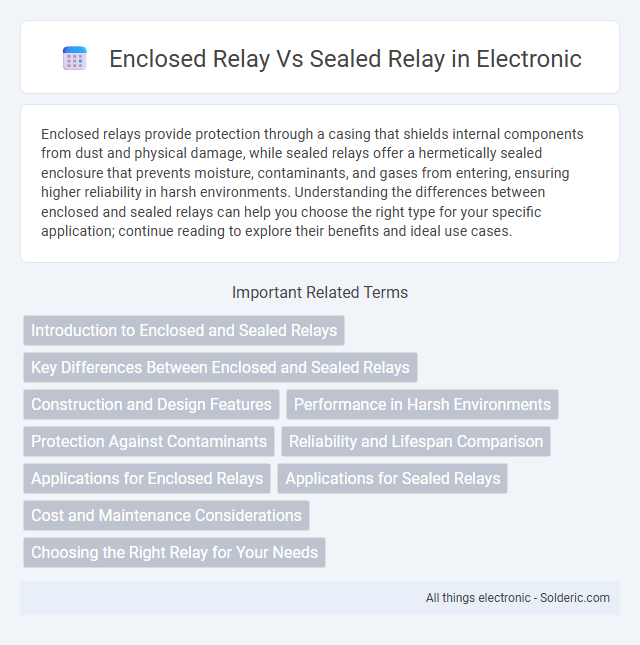Enclosed relays provide protection through a casing that shields internal components from dust and physical damage, while sealed relays offer a hermetically sealed enclosure that prevents moisture, contaminants, and gases from entering, ensuring higher reliability in harsh environments. Understanding the differences between enclosed and sealed relays can help you choose the right type for your specific application; continue reading to explore their benefits and ideal use cases.
Comparison Table
| Feature | Enclosed Relay | Sealed Relay |
|---|---|---|
| Housing | Enclosed in a protective casing, usually plastic or metal | Hermetically sealed to prevent contaminants |
| Protection Level | Moderate protection against dust and moisture | High protection, fully resistant to dust, moisture, and gases |
| Durability | Good for standard industrial environments | Enhanced durability in harsh environments |
| Applications | General purpose, indoor use | Harsh or outdoor environments requiring superior protection |
| Cost | Lower cost compared to sealed relays | Higher cost due to advanced sealing |
| Lifespan | Standard operational lifespan | Longer lifespan due to contamination resistance |
| Maintenance | Requires periodic inspection | Minimal maintenance needed |
Introduction to Enclosed and Sealed Relays
Enclosed relays feature a protective casing that shields internal components from dust and physical damage, enhancing durability in industrial environments. Sealed relays are hermetically sealed to prevent moisture, chemicals, and contaminants from penetrating the relay, ensuring reliable operation in harsh or hazardous conditions. Both designs improve relay longevity but differ in the level of environmental protection provided, with sealed relays offering superior sealing for sensitive applications.
Key Differences Between Enclosed and Sealed Relays
Enclosed relays are housed within protective casings that safeguard internal components from dust and mechanical damage, whereas sealed relays feature hermetic seals that prevent moisture, contaminants, and gases from entering, ensuring higher reliability in harsh environments. The key differences lie in their construction, with sealed relays offering superior environmental protection and longer operational lifespans compared to enclosed relays, which may be suitable for less demanding conditions. Understanding these distinctions helps you select the appropriate relay type based on your application's sensitivity to environmental factors and durability requirements.
Construction and Design Features
Enclosed relays feature a protective casing that shields internal components from dust and debris while allowing some ventilation to prevent overheating, making them suitable for general-purpose applications. Sealed relays incorporate a hermetically sealed design that completely isolates the internal contacts and coils from environmental contaminants such as moisture and corrosive gases, enhancing durability in harsh or demanding conditions. Your choice between enclosed and sealed relay depends on the specific operational environment and the level of protection required for optimal performance.
Performance in Harsh Environments
Sealed relays provide superior protection against dust, moisture, and corrosive substances, making them ideal for harsh environments where reliability is critical. Enclosed relays offer a protective housing but may not fully prevent ingress of contaminants under extreme conditions, potentially impacting long-term performance. For applications in industrial, marine, or outdoor settings, sealed relays ensure consistent electrical contact and extended durability.
Protection Against Contaminants
Enclosed relays provide protection against dust, moisture, and other environmental contaminants by housing the relay components within a protective casing. Sealed relays offer enhanced protection by completely encapsulating the internal parts, preventing any ingress of contaminants such as dirt, water, or corrosive substances. Your choice between enclosed and sealed relays should consider the specific contamination risks in your operating environment to ensure optimal reliability and lifespan.
Reliability and Lifespan Comparison
Enclosed relays feature a protective housing that shields internal components from dust and moisture, enhancing reliability in standard environments but may allow limited contamination over time. Sealed relays offer superior protection through hermetic sealing, significantly reducing exposure to environmental factors and extending operational lifespan, especially in harsh or corrosive conditions. The sealed relay's robust design typically results in higher reliability and longer service life compared to enclosed relays in demanding applications.
Applications for Enclosed Relays
Enclosed relays are widely used in industrial automation, HVAC systems, and motor control applications due to their enhanced protection against dust, dirt, and moisture. These relays offer reliable performance in harsh environments where exposure to contaminants and mechanical impact is common. Their robust construction ensures long operational life and consistent switching in manufacturing facilities and outdoor electrical panels.
Applications for Sealed Relays
Sealed relays are ideal for applications requiring protection against dust, moisture, and contaminants, such as in medical devices, automotive systems, and industrial controls. Their hermetically sealed construction ensures reliability in harsh environments and extends operational lifespan. These relays are commonly used in aerospace, telecommunications, and precision instrumentation where consistent performance is critical.
Cost and Maintenance Considerations
Enclosed relays typically offer lower initial costs but may require more frequent maintenance due to exposure to dust and moisture, increasing long-term expenses. Sealed relays, with their protective hermetic or epoxy sealing, demand less maintenance and enhance reliability, reducing downtime costs despite a higher upfront investment. Your choice impacts overall project budget, balancing immediate purchase price against maintenance frequency and service life.
Choosing the Right Relay for Your Needs
Choosing the right relay involves understanding key differences between enclosed and sealed relays, with enclosed relays providing basic protection against dust and debris, while sealed relays offer enhanced resistance to moisture and contaminants through airtight construction. Enclosed relays are ideal for indoor applications with controlled environments, whereas sealed relays suit harsh conditions requiring high reliability and durability. Evaluating environmental exposure, electrical load, and longevity requirements ensures optimal relay performance and protection for specific industrial or commercial uses.
Enclosed relay vs sealed relay Infographic

 solderic.com
solderic.com